Effect of Premixed Ethanol Ratio Based on the Same Heating Value on the Atomization of Diesel Fuel Injected in the Cylinder
Abstract
:1. Introduction
2. Experimental and Numerical Descriptions
2.1. Experimental Descriptions
2.2. Numerical Descriptions
3. Results
3.1. Validation of Numerical Models
3.2. The Effect of Ethanol Ratio on the Characteristics of Spray Evolution
3.3. The Effect of Ethanol Ratio on the Fuel Behavior Characteristics
3.4. The Effect of Ethanol Ratio on the Equivalence Ratio Distribution Characteristics
4. Conclusions
- In the case of D60/E40, it was observed that the spray tip penetration value was slightly decreased at the time after the start of the 4 deg of diesel injection because the diesel injection was completed due to the shorter diesel injection duration compared to the other diesel injection amount.
- When the premixed ethanol ratio based on the same total heating value in-cylinder increased, the SMD value was also more enormous, up to 32.58%, because of the low kinetic energy of the injected fuel by the short injection duration and the slow evaporation of the injected fuel by the low cylinder temperature.
- At tASOI = 5 deg, when the premixed ethanol ratio based on the same total heating value in-cylinder was increased, the overall value of the equivalence ratio was increased because the amount of premixed ethanol was increased. However, at tASOI = 10 deg, the overall value of the equivalence ratio was decreased because many unevaporated diesel droplets remained in the cylinder due to the slowly evaporating injected diesel fuel.
- At tASOI = 10 deg, it was observed that when the premixed ethanol ratio based on the same total heating value in-cylinder was increased, the amount of injected diesel fuel was decreased, and the amount of diesel fuel introduced into the squish volume was also decreased.
- It is expected that the combustion performance will be promoted by increasing the ethanol ratio based on the same total heating value of the introduced fuels into the cylinder because the amount of diesel fuel with a high heating value introduced into the squish volume was small.
Author Contributions
Funding
Institutional Review Board Statement
Informed Consent Statement
Data Availability Statement
Conflicts of Interest
References
- Rohani, B.; Park, S.S.; Bae, C.S. Effect of injection strategy on smoothness, emissions and soot characteristics of PCCI-conventional diesel mode transition. J. Appl. Therm. Eng. 2016, 93, 1033–1042. [Google Scholar] [CrossRef]
- Pandey, S.K.; Vandana, S.; Akella, S.R.S.; Ravikrishna, R.V. Potential of early direct injection (EDI) for simultaneous NOX and soot emission reduction in a heavy duty turbocharged diesel engine. J. Appl. Therm. Eng. 2019, 158, 113762. [Google Scholar] [CrossRef]
- Cha, J.P.; Yoon, S.J.; Lee, S.H.; Park, S.W. Effect of intake oxygen mole fraction on the near-stoichiometric combustion and emission characteristics of a CI (compression ignition) engine. J. Energy 2015, 80, 677–686. [Google Scholar] [CrossRef]
- Min, S.H.; Suh, H.K.; Cha, J.P. Effect of simulated-EGR (N2) on the distribution characteristics of equivalence ratio and the formation of exhaust emissions in a CI engine under early injection conditions. J. Energy 2020, 199, 116850. [Google Scholar] [CrossRef]
- Kook, S.H.; Kong, J.S.; Park, S.I.; Bae, C.S.; Kim, J.H. The effect of injection angle and nozzle diameter on HCCI combustion. Trans. KSAE 2007, 15, 1–7. [Google Scholar]
- Peng, Z.; Zhao, H.; Ma, T. Characteristics of premixed homogeneous charge compression ignition (HCCI) diesel combustion and emissions. J. Combust. Sci. Technol. 2005, 177, 2113–2150. [Google Scholar] [CrossRef] [Green Version]
- Kim, M.Y.; Lee, C.S. Effect of a narrow fuel spray angle and a dual injection configuration on the improvement of exhaust emissions in a HCCI diesel engine. J. Fuel 2007, 86, 2871–2880. [Google Scholar] [CrossRef]
- Kumar, K.S.; Raj, R.T.K. Effect of fuel injection timing and elevated intake air temperature on the combustion and emission characteristics of dual fuel operated diesel engine. J. Procedia Eng. 2013, 64, 1191–1198. [Google Scholar] [CrossRef] [Green Version]
- Pan, W.; Yao, C.D.; Han, G.P.; Wei, H.Y.; Wang, Q.G. The impact of intake air temperature on performance and exhaust emissions of a diesel methanol dual fuel engine. J. Fuel 2015, 162, 101–110. [Google Scholar] [CrossRef]
- Rocha, H.M.Z.; Pereira, R.D.S.; Nogueira, M.F.M.; Belchior, C.R.P.; Tostes, M.E.D.L. Experiment investigation of hydrogen addition in the intake air of compressed ignition engines running on biodiesel blend. Int. J. Hydrogen Energy 2017, 42, 4530–4539. [Google Scholar] [CrossRef]
- Singh, A.P.; Kumar, V.; Agarwal, A.K. Evaluation of comparative engine combustion, performance and emission characteristics of low temperature combustion (PCCI and RCCI) modes. J. Appl. Energy 2020, 278, 115644. [Google Scholar] [CrossRef]
- Jo, S.I.; Park, S.H.; Kim, H.J.; Lee, J.T. Combustion improvement and emission reduction through control of ethanol ratio and intake air temperature in reactivity controlled compression ignition combustion engine. J. Appl. Energy 2019, 250, 1418–1431. [Google Scholar] [CrossRef]
- AVL List GmbH. Fire Version 2013 ESE-Diesel (Engine Simulation Environment) Module Manual; AVL List GmbH: Graz, Austria, 2013. [Google Scholar]
- AVL GmbH. Fire Version 2013.2 Spray Module Manual; AVL GmbH: Graz, Austria, 2013. [Google Scholar]
- Suh, H.K.; Lee, C.S. A review on atomization and exhaust emissions of a biodiesel-fueled compression ignition engine. J. Renew. Sustain. Energy Rev. 2016, 58, 1601–1620. [Google Scholar] [CrossRef]
- Bosch, W. The Fuel Rate Indicator: A New Measuring Instrument for Display of the Characteristics of Individual Injection. SAE Trans. 1967, 75, 641–662. [Google Scholar]
- Lee, S.; Reitz, R.D. Spray Targeting to Minimize Soot and CO Formation in Premixed Charge Compression Ignition (PCCI) Combustion with a HSDI Diesel Engine; SAE Technical Paper 2006-01-0918; SAE International: Warrendale, PA, USA, 2006; Volume 115, pp. 1–12. [Google Scholar]
- Lefebvre, A.H.; McDonell, V.G. Atomization and Spray; Taylor & Francis: Abingdon, UK, 1989; pp. 41–54. [Google Scholar]
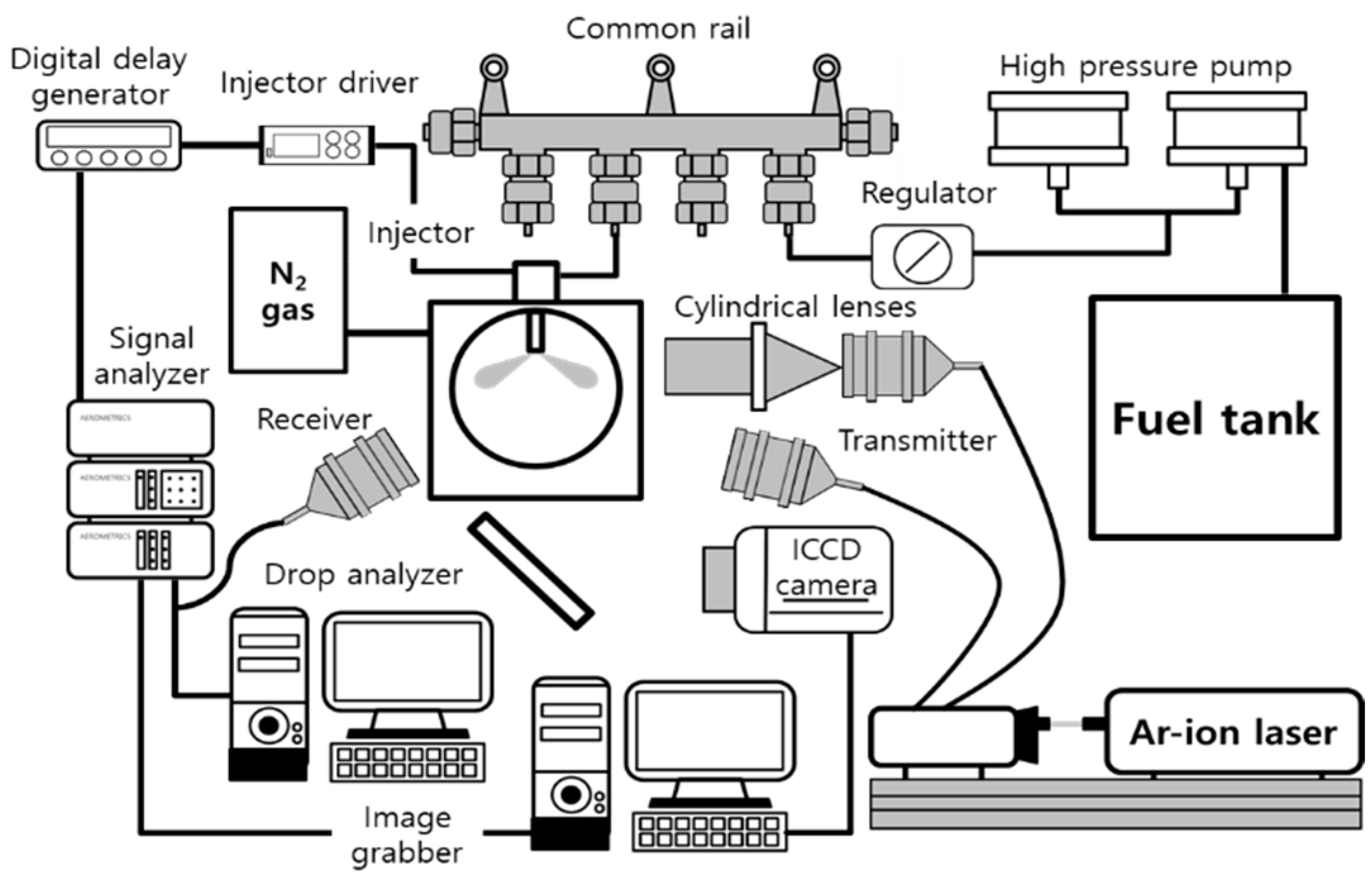

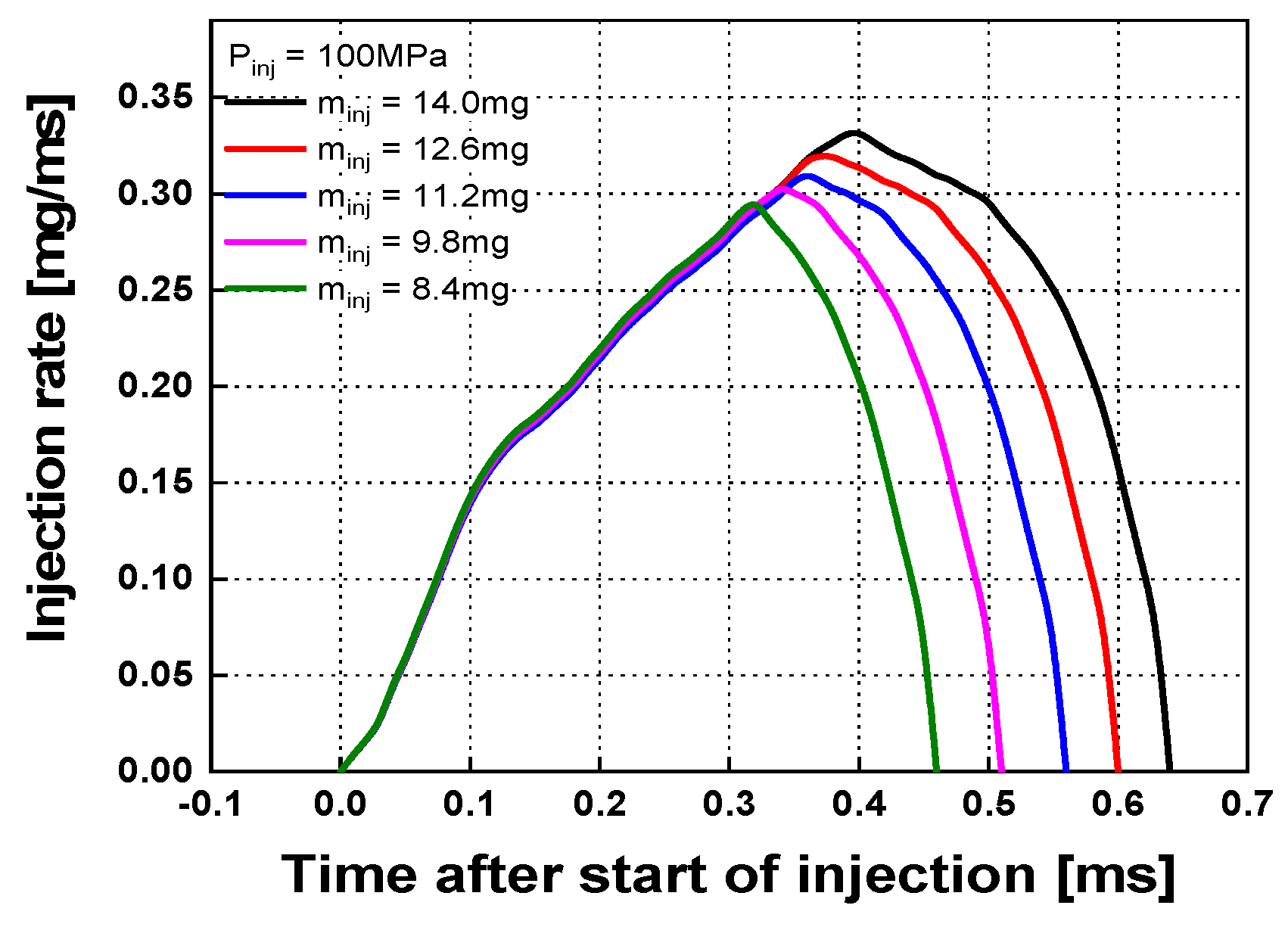

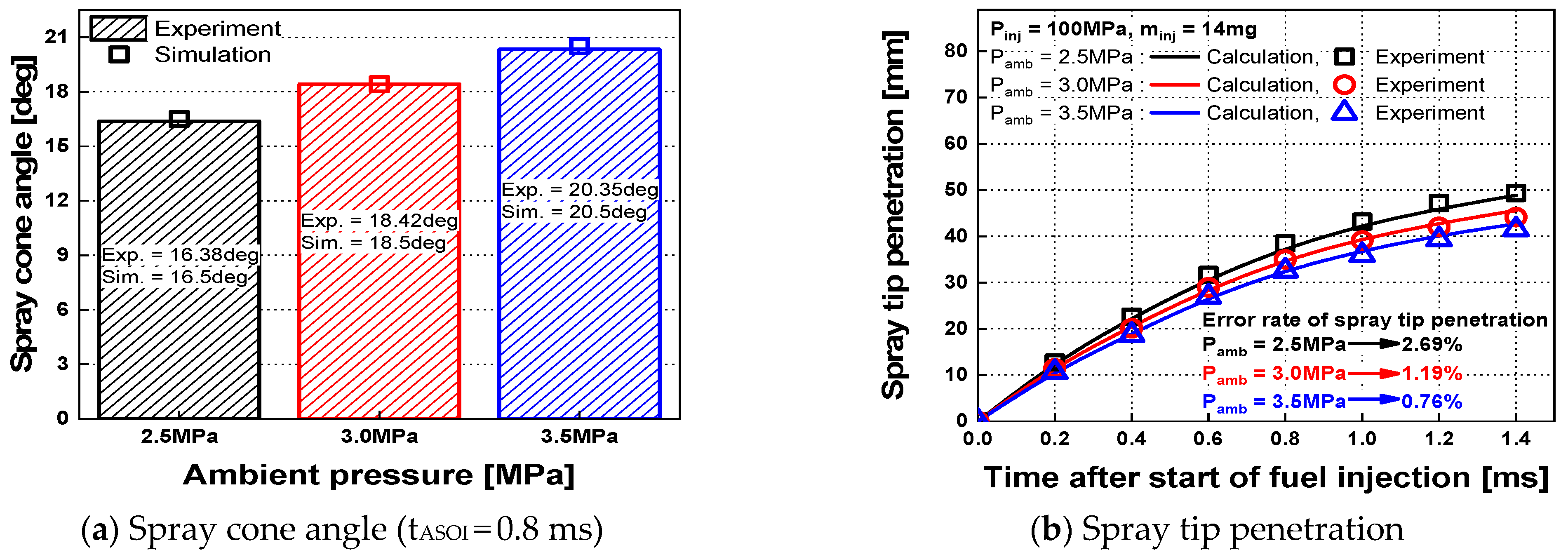
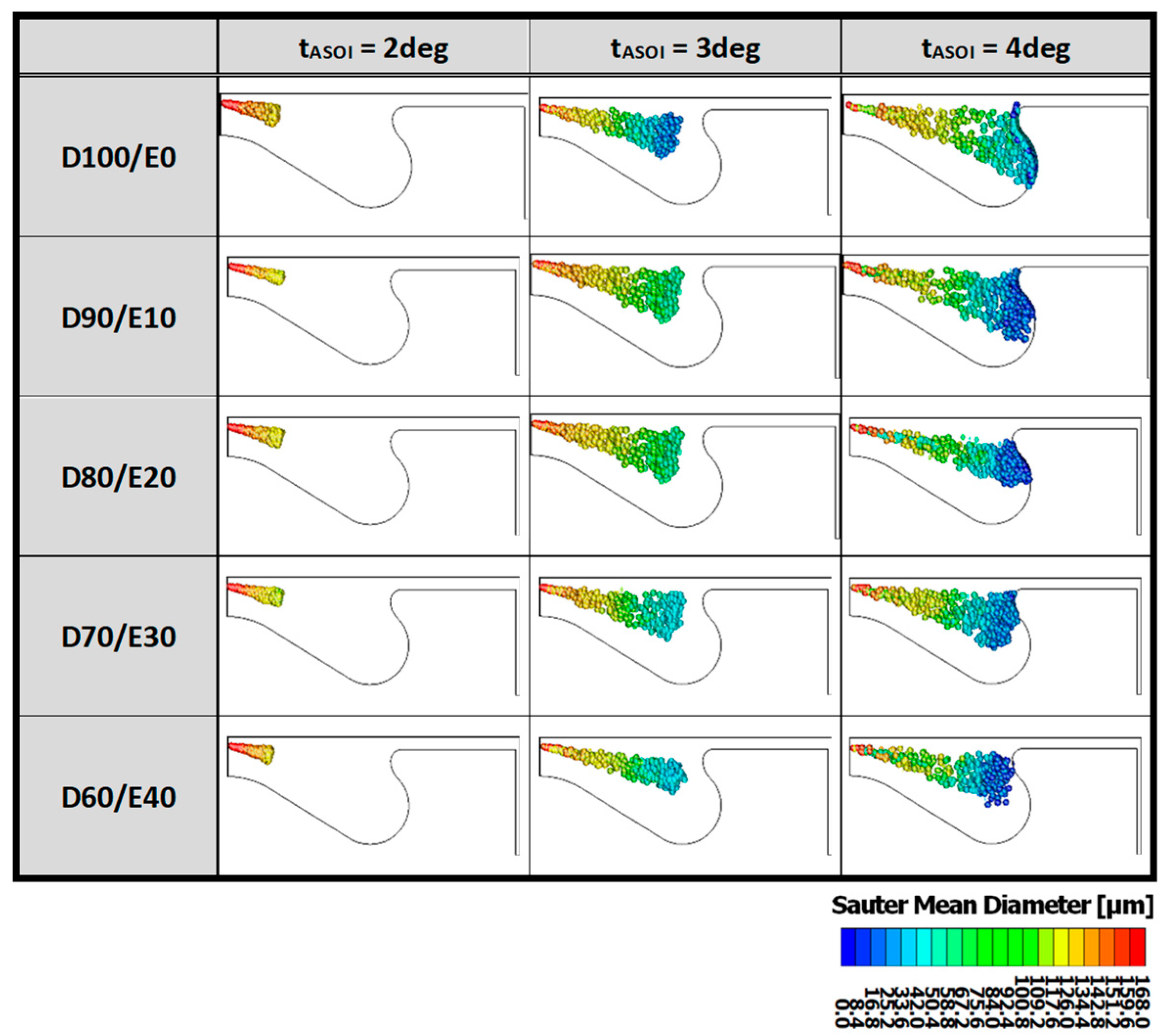

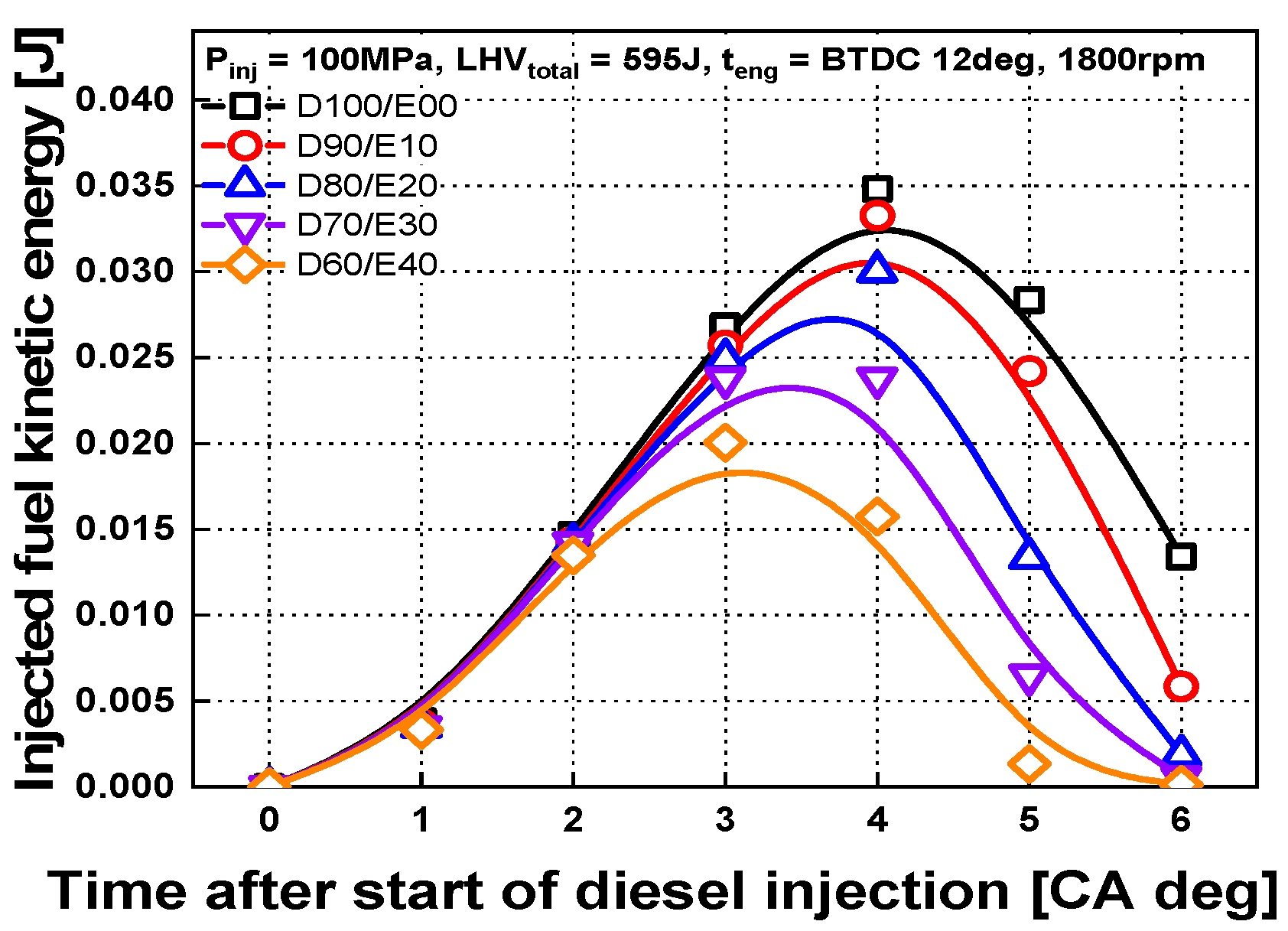
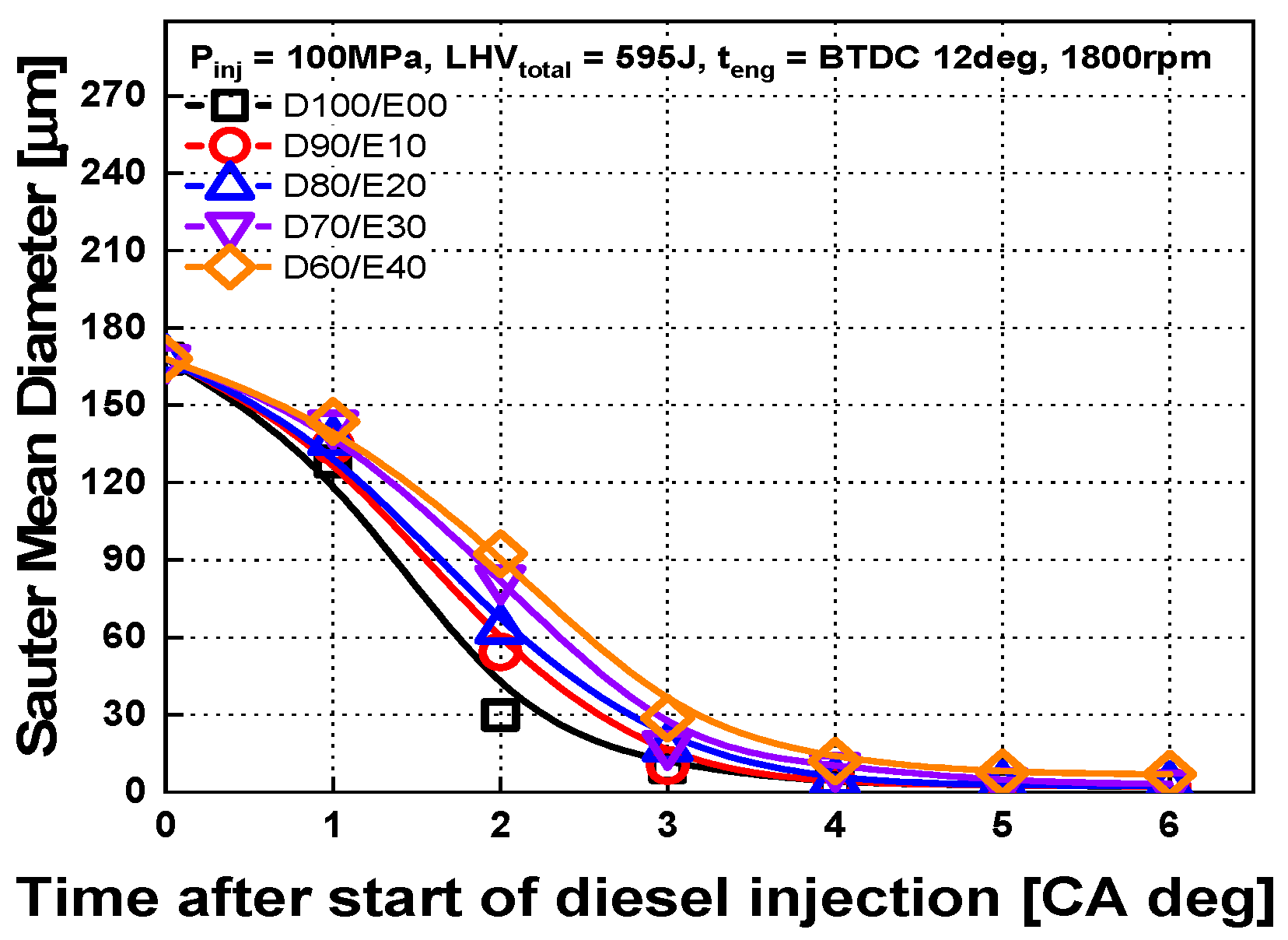
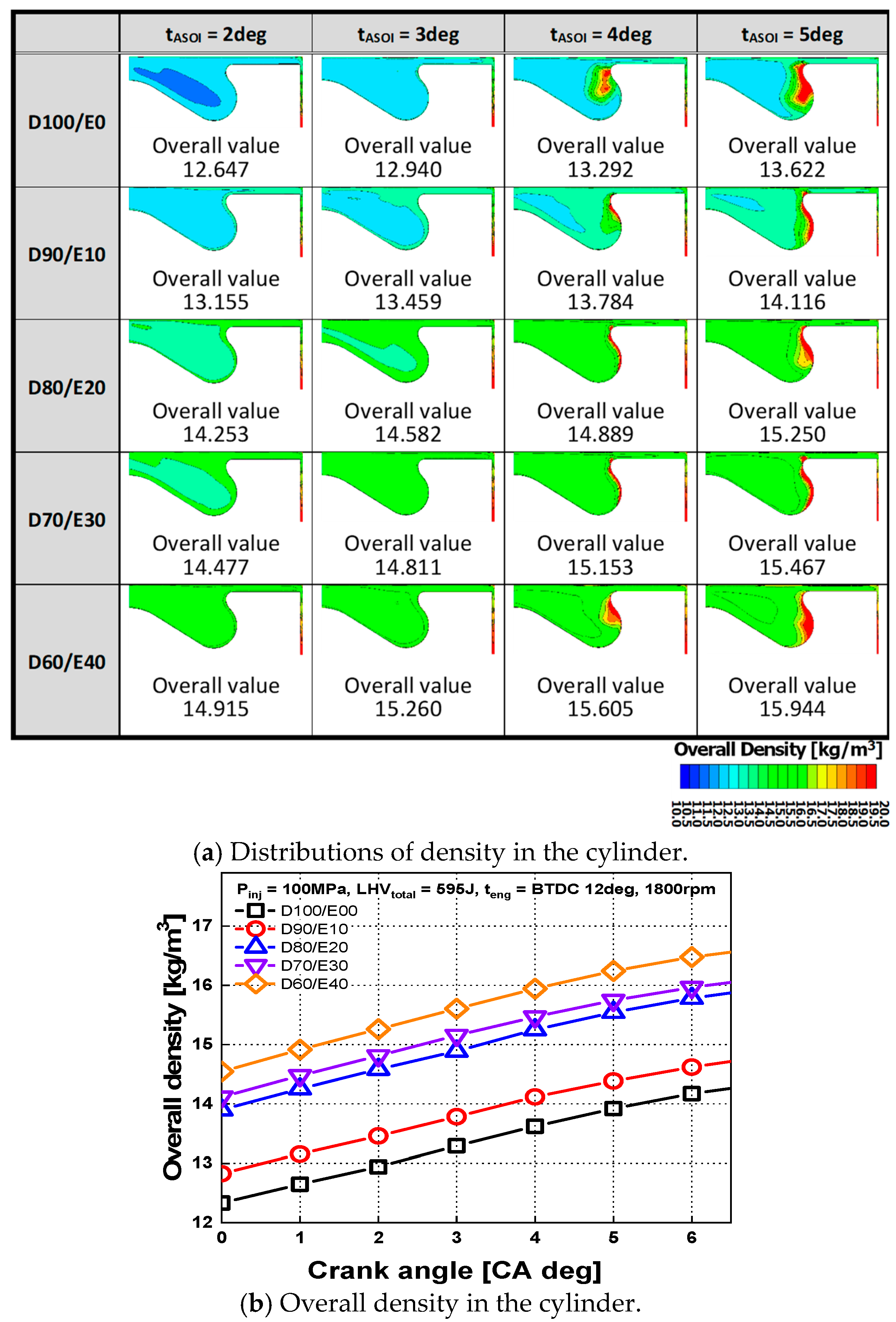
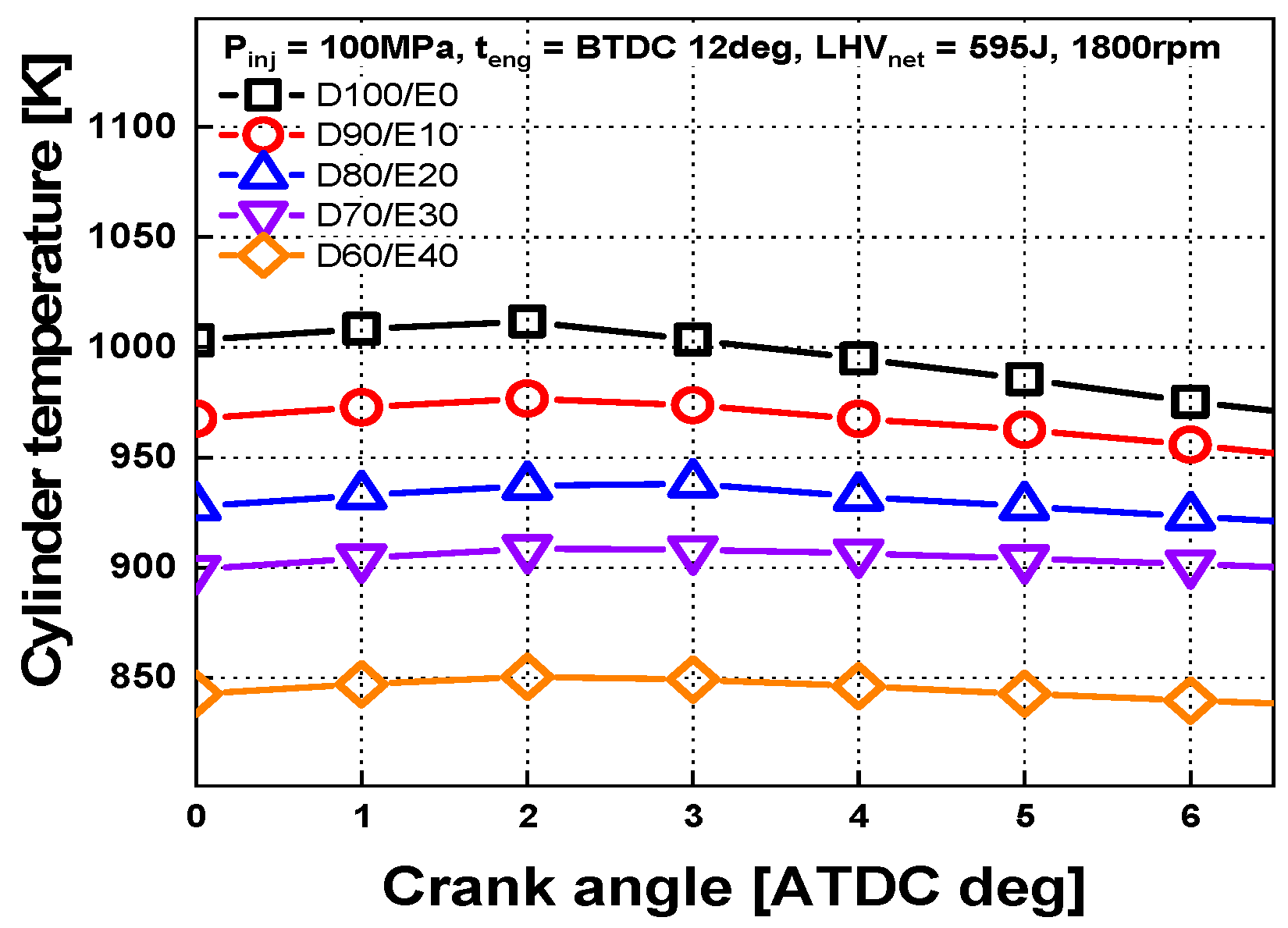
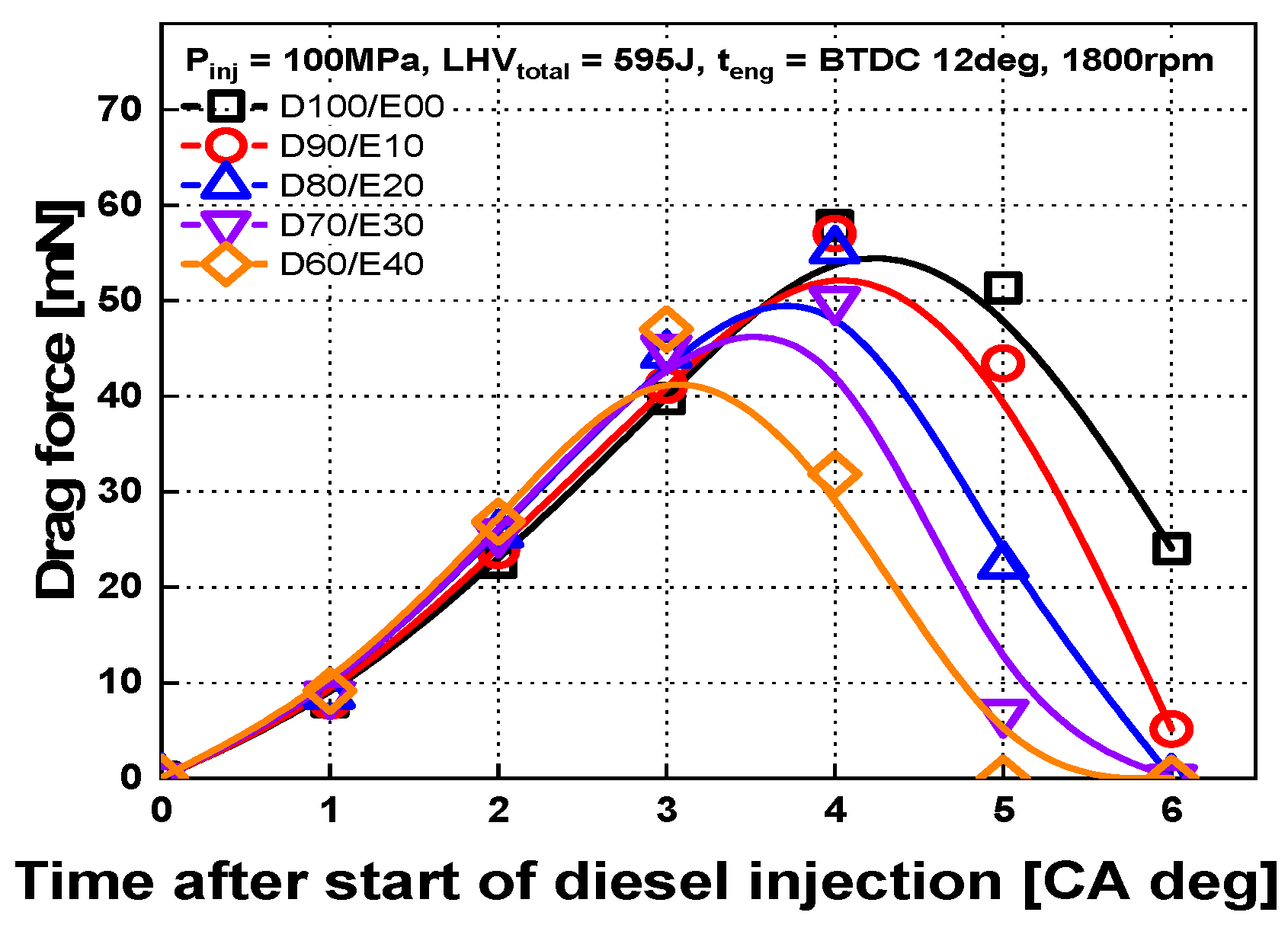
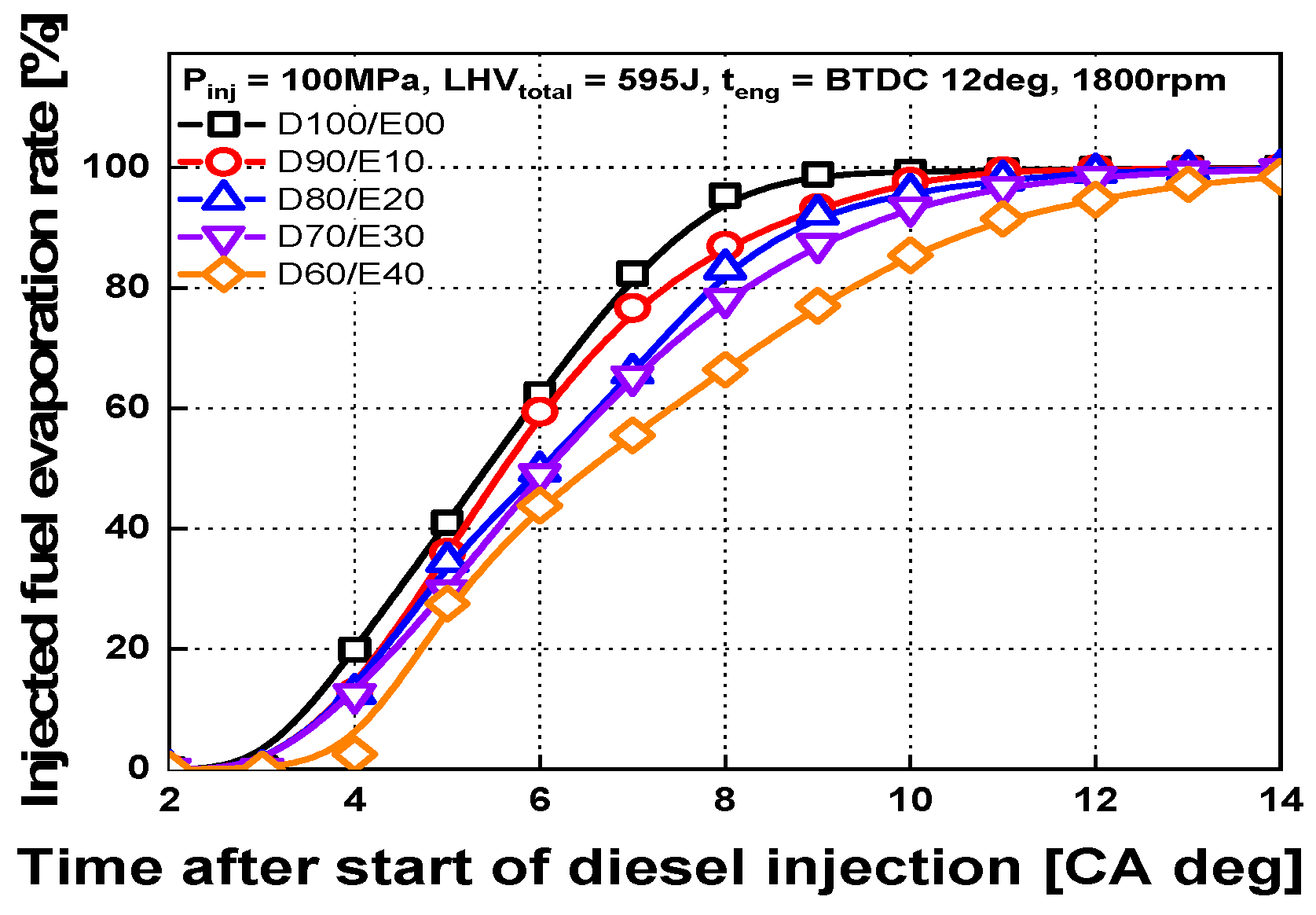

| Item | Specification | |
|---|---|---|
| Engine | Engine type | Single cylinder |
| Bore/Stroke | 83 mm/92 mm | |
| Displacement | 498 cc | |
| Compression ratio | 17.7 | |
| Injector | Nozzle | 5 hole mini-sac type |
| Hole diameter | 0.168 mm | |
| Inclined spray angle | 154 deg |
| Item | Diesel | Ethanol |
|---|---|---|
| LHV: lower heating value [MJ/kg] | 42.5 | 26.8 |
| Latent heat of evaporation [kJ/kg] | 250 | 846 |
| Density @ 20 °C [kg/m3] | 838.2 | 789.4 |
| Carbon content [% mass] | 86.7 | 52.14 |
| Hydrogen content [% mass] | 12.71 | 13.13 |
| Sulfur content [% mass] | 0.041 | - |
| Oxygen content [% mass] | - | 34.73 |
| Flash point [°C] | 67 | 13 |
| Kinematic viscosity @ 40 °C [mm2/s] | 2.8271 | 1.056 |
| Typical formula | C14.09H24.78 | C2H6O |
| Cetane number | 42.6 | 8.5 |
| Lubricity, HFRR @60 °C [m] | Max. 520 | Max. 605 |
| Fuel Injection Ratio [Main/Premixed] | Fuel Amount [mg] | Heating Value [J] | O2 Mass Fraction [-] | N2 Mass Fraction [-] | Ethanol Mass Fraction [-] |
|---|---|---|---|---|---|
| D100/E0 | 14/0 | 595/0 | 0.23200 | 0.76800 | 0.00000 |
| D90/E10 | 12.6/2.2 | 535.5/59.5 | 0.23081 | 0.76407 | 0.00512 |
| D80/E20 | 11.2/4.4 | 476/119 | 0.22984 | 0.76084 | 0.00932 |
| D70/E30 | 9.8/6.7 | 416.5/178.5 | 0.22876 | 0.75273 | 0.01396 |
| D60/E40 | 8.4/8.9 | 357/238 | 0.22781 | 0.75413 | 0.01806 |
| Contents | Numerical Analysis |
|---|---|
| RPM | 1800 |
| Injection pressure [MPa] | Diesel: 100, ethanol: 10 |
| Total heating value [J] | 595 |
| Start of energizing timing [ATDC deg] | −12 |
| Fuel injection ratio [main fuel/premixed fuel] | D100/E0, D90/E10, D80/E20,D70/E30, D60/E40 |
Disclaimer/Publisher’s Note: The statements, opinions and data contained in all publications are solely those of the individual author(s) and contributor(s) and not of MDPI and/or the editor(s). MDPI and/or the editor(s) disclaim responsibility for any injury to people or property resulting from any ideas, methods, instructions or products referred to in the content. |
© 2023 by the authors. Licensee MDPI, Basel, Switzerland. This article is an open access article distributed under the terms and conditions of the Creative Commons Attribution (CC BY) license (https://creativecommons.org/licenses/by/4.0/).
Share and Cite
Min, S.-H.; Suh, H.-K. Effect of Premixed Ethanol Ratio Based on the Same Heating Value on the Atomization of Diesel Fuel Injected in the Cylinder. Fire 2023, 6, 249. https://doi.org/10.3390/fire6070249
Min S-H, Suh H-K. Effect of Premixed Ethanol Ratio Based on the Same Heating Value on the Atomization of Diesel Fuel Injected in the Cylinder. Fire. 2023; 6(7):249. https://doi.org/10.3390/fire6070249
Chicago/Turabian StyleMin, Se-Hun, and Hyun-Kyu Suh. 2023. "Effect of Premixed Ethanol Ratio Based on the Same Heating Value on the Atomization of Diesel Fuel Injected in the Cylinder" Fire 6, no. 7: 249. https://doi.org/10.3390/fire6070249






